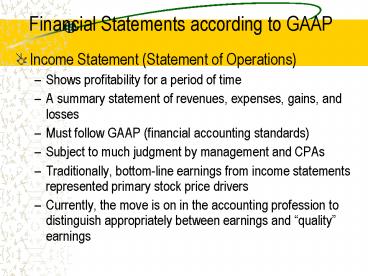Financial Statements according to GAAP PowerPoint PPT Presentation
1 / 12
Title: Financial Statements according to GAAP
1
Financial Statements according to GAAP
- Income Statement (Statement of Operations)
- Shows profitability for a period of time
- A summary statement of revenues, expenses, gains,
and losses - Must follow GAAP (financial accounting standards)
- Subject to much judgment by management and CPAs
- Traditionally, bottom-line earnings from income
statements represented primary stock price
drivers - Currently, the move is on in the accounting
profession to distinguish appropriately between
earnings and quality earnings
2
The Balance Sheet (Financial Position)
- Determines Solvency Position of an organization
on a given date - Assets (Resources) Future economic value owned
or controlled by the organization - Current--Cash and near cash assets
- Non-currentRelatively permanent assets used to
generate revenue - Liabilities (Debts) Future claims by outsiders
on assets of the organization - CurrentDue in the near future
- Long-termDue at least one year from the balance
sheet date - Stockholders EquityOwners claim to
organization resources
3
Statement of Cash Flows
- Summarizes cash inflows and (outflows) for a
period of time - Includes all cash inflows (outflows) regardless
of source or use - Categories of cash flows
- Operating Activities Shows cash flows from
operating income (from income statement) - Investing Activities Shows cash flows to
investments and from sales of investments - Financing Activities Shows cash flows from
borrowing and sales of original equity issues and
subsequent pay back of loans, equity
re-acquisitions, and dividends
4
Sources of Financial Analysis Tools
- Finance and Accounting Texts
- Dess-Lumpkin Text pp 98-117
- Stickney-Brown Text (5th Ed)
- Handout Link in your tentative schedule (Best
Source) - Uses averages instead of end-of-year figures
where appropriate and cost of goods sold instead
of sales in inventory turnover calculations - Emphasizes DuPont Model for R.O.I. calculations
- More cash flow analyses included
5
Financial Statement Analysis
- Profitability Analysis
- Return on Investment (ROI)
- Return / Average Investment
- DuPont Model
- Return / Sales X Sales / Average Investment
- Sales Margin X Asset Turnover
- Return on Equity (ROE)
- Return / Average Stockholders Equity
- Others PE Ratio Dividend Yield Dividend
Payout - Also be sure to compare your company stock price
trend with some of the major price indices.
6
Why We Use Averages in Denominators
- Assume Total Assets at Beginning of Year 500
- At July 1, we acquire 500 in new plant assets
- Net income (return on investment) for year is 50
- If we use asset value at end of year
- ROI .05 (50/ 1,000)
- If we use average asset value
- ROI .067 (50/ (500 1,000)/2
- Use of average assets gives a more accurate
annual return on your investment (The 50 was
earned during the last six months of the year)
7
Advantage of Using DuPont Model
- Identifies cause of change in ROI from year to
year - Uses the product of two intermediate calculations
for sales margin (efficiency measure) and asset
turnover (effective utilization of assets to
generate revenue) - Assume the following information as an example
Year 01 Net Income-50 Average Assets-800
Sales-1,000
Year 02 Net Income-50 Average Assets-1,000
Sales-2,000
8
Calculation of ROI Both Methods
- Year 01 Year
02 - Regular 50/800 .0625 50/1,000 .05
- DuPont
- 50/1,000 1,000/800 50/2,000
2000/1000 - .05 1.25
.025 2 - .0625
.05
9
Liquidity Analysis
- Working Capital
- Working Capital Current Assets Current
Liabilities - Current Ratio Current Assets / Current
Liabilities - Acid Test Ratio Cash, Temporary Investments and
Receivables / Current Liabilities - Cash and Equivalents
- Cash Flow Adequacy
- Debt Coverage (Debt Payback)
- Operations Index
- Others include Reinvestment ratio, cash flow to
sales, and cash flow return on average assets
10
Activity and Efficiency Measures
- Property-Plant-Equipment Turnover
- Inventory Turnover (Days sales in inventory)
- Accounts Receivable Turnover (Days sales in
accounts receivable)
11
Financial Leverage Analysis
- Debt Ratio
- Debt to Equity Ratio
- Times Interest Earned
- Times Interest Covered by Cash Flow from
Operating Activities - Wisely used outside capital injections greatly
improve owners return on equity - Unwise use of outside capital adds burdensome
fixed costs and contribute to increased risk of
the organization
12
WHY FINANCIAL ANALYSIS?
- Solvency Evaluation (Short-range and Long-range)
- Changes in Company Value (Owners net worth)
- Earnings and Quality of Earnings Trend
- Management Efficiency
- Utilization and Control of Organization Resources
(Assets) - Cash Generation Efficiency of Organization
- Risk Assessment

